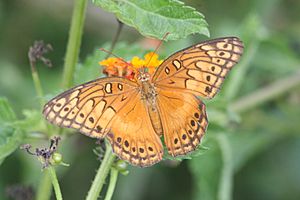Mexican fritillary facts for kids
Quick facts for kids Mexican Fritillary |
|
|---|---|
 |
|
| Scientific classification | |
| Kingdom: | |
| Phylum: | |
| Class: | |
| Order: | |
| Family: | |
| Subfamily: |
Heliconiinae
|
| Genus: | |
| Species: |
E. hegesia
|
| Binomial name | |
| Euptoieta hegesia (Cramer, 1779)
|
|
The Mexican Fritillary (its scientific name is Euptoieta hegesia) is a beautiful butterfly found in North America and South America. It belongs to a group of butterflies called the Nymphalidae family.
Contents
What Does the Mexican Fritillary Look Like?
This butterfly has bright orange wings on top. Its back wings (called hind wings) usually don't have many black marks. Both its front wings (fore wings) and hind wings have a line of black spots near the edges.
The underside of its wings is yellow-orange. These parts do not have the black spots found on the top side. The Mexican Fritillary has a wingspan of about 2.5 to 3 inches (6.3 to 7.6 centimeters).
How to Tell it Apart from Similar Butterflies
The only butterfly that looks very similar to the Mexican Fritillary in its home areas is the Variegated Fritillary (Euptoieta claudia).
You can tell them apart by looking closely:
- The Variegated Fritillary has more black markings on the top side of its hind wings.
- The underside of the Variegated Fritillary's hind wing has a light-colored band in the middle. The Mexican Fritillary does not have this band.
When Can You See Them Flying?
The Mexican Fritillary can be seen flying during different times of the year, depending on where it lives:
- In Arizona, you might see them from mid-June to November.
- In Texas, they fly from July to December.
- In Mexico, you can spot them all year long!
Where Do Mexican Fritillaries Live?
These butterflies like to live in many different kinds of open areas. You can often find them in gardens and other sunny places.
Life Cycle of the Mexican Fritillary
The Mexican Fritillary goes through several stages in its life.
The Caterpillar Stage
The caterpillar (larva) of this butterfly is shiny red. It has a silver stripe with black edges on each side of its body. Along its back, it has silver spots also outlined in black. The caterpillar also has six rows of black spines. Its head has two long, black spines that look like they have clubs on the ends.
The Chrysalis Stage
After the caterpillar grows, it turns into a chrysalis (pupa). The chrysalis is usually dark brown or tan. It has gold-colored eyes and short gold spines. On the parts that will become the wings, there is a black mark shaped like a "T".
Mexican Fritillaries usually have 1 to 3 groups of offspring (called broods) each year.
What Do Mexican Fritillary Caterpillars Eat?
Mexican Fritillary caterpillars feed on specific plants, which are called host plants. Here are some of the plants they like to eat:
- Ipomoea maritima (used in Brazil)
- Passiflora foetida - also known as Foetid Passionflower
- Turnera ulmifolia - also known as Yellow Alder (used in Mexico and the Antilles)

